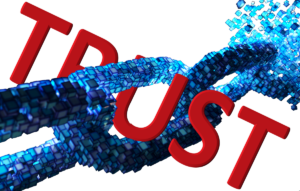As a technology, blockchain remains in its very early stages. For that reason alone, pundits are writing a lot about blockchain’s hypes, hopes, and hurdles. Blockchain expectations are especially high in the supply chain arena. Christopher Hamman (@tikaridemigod) writes, “Valued at $8.1 trillion today, the global supply chain and logistics industry is the backbone of our global economy. With the emergence of blockchain technology, this industry can become more efficient and profitable than ever before thanks to increased transparency, speed, and accountability.”[1] Beyond the hype, there is real hope that blockchain can tackle chronic challenges found in global supply chains. Scott Sopher, Deloitte’s Global Supply Chain practice leader, explains, “The digital, interconnected world demands that supply chains also serve as a connected, coordinated information ecosystem that delivers maximum flexibility, visibility, and transparency.” The interconnected world might demand such supply chains, but achieving those goals has proved elusive. Supply chain professionals hope blockchain technology can help. In Part 1 of this article, I want to discuss the hype and hopes surrounding blockchain. In Part 2, I will discuss the hurdles that must be overcome before blockchain can be widely used.
Hype and hopes of blockchain technology in supply chain operations
“Supply chain management is currently undergoing a transformational moment,” writes Gerald Fenech (@gerald2273). “Past antiquated systems are proving to be unsuccessful in navigating the complexity and immediacy of the modern supply chain, and new models are emerging that promise to improve these systems. In particular, blockchain, a prolific technology that began as the underpinning for digital currencies, is proving useful in this regard.”[3] Andres Richter, CEO of Priority Software, adds, “Blockchain … is now being touted as the next big thing in disruptive enterprise technology. Enterprises are currently exploring how the technology can help them increase transparency, potentially save on costs, and speed up business processes.”[4] Like Fenech, Richter insists the supply chain is one of the most promising areas for using blockchain. He writes, “Although the technology is far from mature, one area where it’s already having a concrete impact is in manufacturing and the supply chain. A recent survey by Capgemini Research Institute found that more than half of organizations were currently experimenting with or implementing blockchain to improve manufacturing and the supply chain.”
“The supply chain has become a powerful differentiator in the age of demanding customers and global complexity,” writes Pam Baker (@bakercom1). “To address this challenge, many companies are turning to next-generation technologies, including blockchain.”[5] To underscore why supply chain professionals are excited about blockchain’s possibilities, Baker discusses four ways blockchain technology can be used to improve supply chains. They are:
1. Fighting supply chain fraud. “Proving you’re giving customers what they paid for is one of blockchain’s biggest draws,” writes Baker. “While there are many appropriate use cases for blockchain in the supply chain, the most common is product provenance, which is tracking the authenticity and integrity of a product. … The returns process is a prime example of where counterfeited goods can be laundered and, thus, overlooked by traditional authentication processes. … Information regarding the [fraudulent] item’s return might not be shared between the brand and the store, and the item might be unwittingly resold to another customer. … The creation of an identity of things is gaining popularity as a way to combat these illegal activities. Using unique IoT identifiers in conjunction with blockchain, supply chain stakeholders can track legally manufactured goods from creation to sale and beyond, and counterfeiters are blocked from slipping their fake wares into legitimate channels.”
2. Ensuring an ethical and sustainable supply chain. Baker writes, “Today’s customers are savvy and demanding, and brand trust factors into decision-making. Customers tend to reward triple-bottom-line companies, and the supply chain bears the brunt of many social responsibility needs.” Because blockchain can be used to track goods from sourcing to sale, it provides both transparency and traceability. Baker adds, “Organizations such as UNICEF are testing blockchain to help ensure social responsibility and other sustainability issues.”
3. Eliminating the middleman. “When it comes to promising use cases for blockchain in the supply chain,” Baker writes, “some point to smart contracts — or cryptocontracts. These contracts run on blockchain and enforce agreements. Blockchain should help increase the speed and efficiency of the supply chain, and digitizing the supply chain removes frictions and middlemen in financing. … As invoicing becomes digitalized, it is automated and synced with validated deliveries and quality checks. Likewise, suppliers should be rewarded with faster payments. … Smart contracts are a boon for supply chain management, as they are meant to increase transparency, ensure proper authentication, limit fraud and eliminate unnecessary middlemen from the process. … The result is savings for buyers, suppliers and end users.”
4. Going paperless. Baker writes, “Many steps along the supply chain are paper-based, and blockchain is one technology that can help digitize transactions. A number of documents are required in global trade. Products shipped via ocean freight are assigned a bill of lading, and many international trades are backed by a letter of credit to lower risk and inject liquidity. Blockchain technology helps eliminate the need for paper documents and replaces them with a trusted electronic equivalent.”
Richter notes, “It’s important to remember that blockchain is an additive technology. It’s not going to replace the need for internal ERP, now or in the future. Instead, ERP systems and blockchain will work together to strengthen the integrity and automation of the supply chain.”
Concluding thoughts
Fenech concludes, “As recent supply chain mishaps remind us, the modern global supply chain is desperately in need of an upgrade. For companies, these changes need to include the scale and nuance required to account for the many moving parts associated with today’s ecosystem. At the same time, the supply chain needs to be as transparent and accessible as possible, benefiting both companies and consumers. The blockchain is poised to provide the technological backbone for these changes, serving as the impetus for a number of profound changes in supply chain management.” As I noted at the beginning of this article, before blockchain becomes ubiquitous within supply chains, there are hurdles that must be overcome. I will discuss those in the concluding part of this article.
Footnotes
[1] Christopher Hamman, “Blockchain is the Catalyst for the Supply Chain Industry,” Coinspeaker, 25 September 2019.
[2] Ibid.
[3] Gerald Fenech, “The Supply Chain Revolution On The Blockchain,” Forbes, 18 December 2018.
[4] Andres Richter, “The building blocks of a better supply chain,” CryptoNewsReview, 21 May 22019.
[5] Pam Baker, “4 ways to use blockchain in the supply chain,” TechTarget, 13 September 2019.





